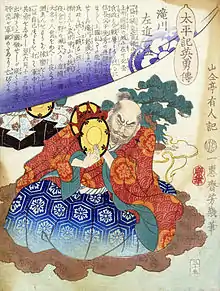Takigawa Kazumasu
Takigawa Kazumasu (滝川 一益, 1525 – October 21, 1586), also known as Sakonshōgen (左近将監), was a samurai retainer to Oda Nobunaga, and later Toyotomi Hideyoshi, during Japan's Sengoku period. His biological son, Toshimasu, was adopted by Toshihisa and later served Nobunaga alongside Kazumasu and Toshimasu's adopted uncle, Maeda Toshiie.
Takigawa Kazumasu 滝川 一益 | |
|---|---|
 Takigawa Kazumasu | |
| Born | 1525 Omi Province |
| Died | October 21, 1586 (aged 60–61) Echizen Province |
| Allegiance | |
| Battles/wars | Battle of Anegawa Battle of Mikatagahara Siege of Nagashima Battle of Tedorigawa Tensho Iga War Battle of Kanagawa Siege of Kameyama Siege of Kanie |
Biography
Originally from Ōmi Province, Takigawa was appointed Kantō-kanrei (Shōgun's Deputy in the East) by Nobunaga; in this post, with a portion of Kōzuke Province as his domain, he was assigned to keep an eye on the powerful Hōjō clan, based at Odawara. Under Nobunaga, he took part in a great many battles, including the battle of Anegawa in (1570), and the campaigns against the Ikkō-ikki of Nagashima (1571–1574).
Kazumasu was sent by Oda Nobunaga to provide reinforcement to Tokugawa Ieyasu when he was attacked by Takeda Shingen at Battle of Mikatagahara (1572), this included Siege of Nagashima (1573) and also fought in Battle of Tedorigawa (1577), and the Tenshō Iga War (1579-1581) in Iga Province.[1]
Following Nobunaga's death in 1582, Takigawa fought in the Battle of Kanagawa (1582) against Hojo clan.[1]:232–233
In 1583, he and Shibata Katsuie along with many of the Oda retainers, initially opposed Toyotomi Hideyoshi, but he was defeated defending Kameyama Castle (Mie), after Hideyoshi used mines to bring down the castle.[2]
Later Kazumasu submitted to Hideyoshi and assisted during the Komaki Campaign (1584) by attacking Kanie castle along with Kuki Yoshitaka. When he performed badly in this campaign, he shaved his head, become a Buddhist monk and retired from battle in shame. He is thought to have died in Echizen around 1586.
Takigawa's standard was three red circles arranged vertically.
References
- Frederic, Louis (2002). Japan Encyclopedia, Cambridge, Massachusetts: Harvard University Press.
- Sansom, George (1961). A History of Japan: 1334–1615, Stanford, California: Stanford University Press.
